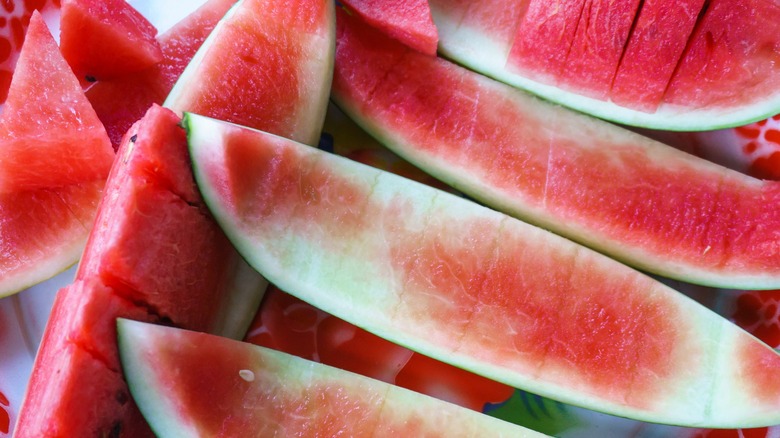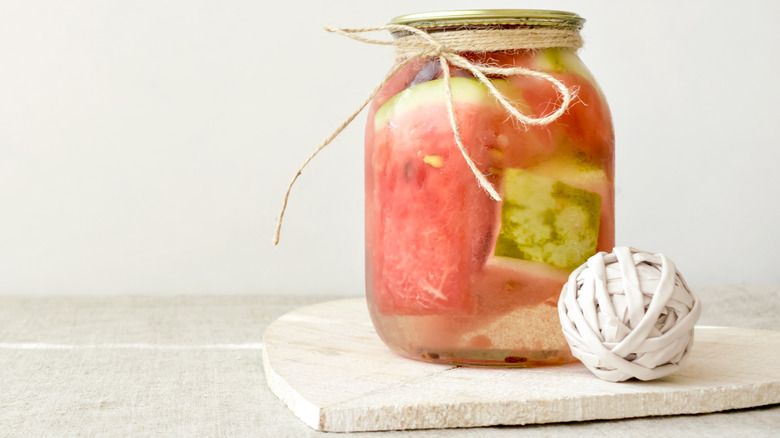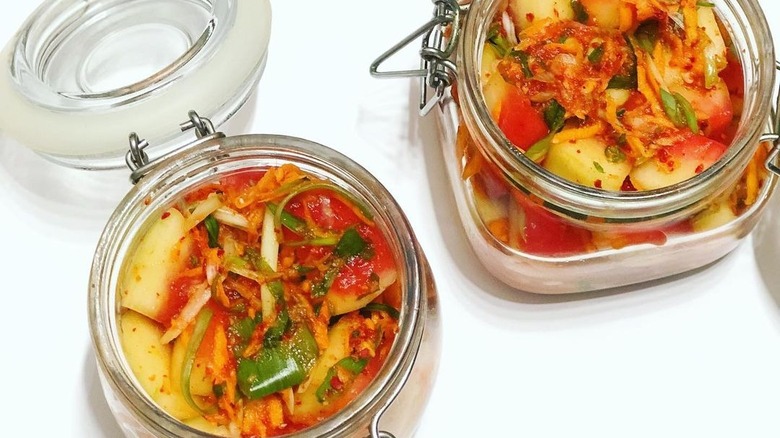Watermelon Kimchi Is Yet Another Reason You Need To Keep Those Rinds
Watermelon is often the quintessential accompaniment for a hot summer day — it gives a bit of refreshment to beat the heat and is delicious and light. Still, as most know, you're left with the unpleasant rind after eating, which typically gets tossed out. However, watermelon rind is a superfood that shouldn't be thrown away and can be repurposed through pickling, preserves, and stir-frying. If that's giving you some ideas for the next time there's a stack of rinds left, keep in mind there's another way to get the most out of the fruit: watermelon rind kimchi.
While most would associate kimchi with a type of cabbage (napa cabbage, to be exact), several types can bypass that particular vegetable. Sometimes, kimchi consists of radish, cucumber, mustard greens, or other components. Lauryn Chun, owner and creator of Mother-In-Law's Kimchi and "The Kimchi Cookbook," expounds on this while talking to Serious Eats about the tasty ingredient's definition, which she believes "is actually more of an active verb... you can 'kimchi' just about anything."
With that in mind, there's a new way to enjoy a beloved summer treat, which also takes care of the leftovers. There are two main ways to make watermelon rind kimchi, depending on whether you want a quick fix or something with a little more fermentation.
How to make watermelon rind kimchi
Before getting into how to make watermelon rind kimchi, it's essential to know how kimchi is made. Traditionally, it is made by taking cabbage or another vegetable and adding ingredients like salt or a brining solution to leech any surplus liquid before flavoring with a paste generally created from gochugaru (a spice mix of dried and crushed Korean chili peppers), fish sauce, scallions, ginger, garlic, and sometimes sesame seeds. After everything's mixed, it's usually sealed in jars or containers and left to sit at ambient temperature for a couple of days to allow fermentation to occur. Although the recipes' wait time differs between one to four days or more, it can be done as quickly as 12 hours, and the process can be used on watermelon rinds.
Still, there's a faster method that doesn't involve any fermenting, and it's incidentally also used for making watermelon rind kimchi. As Ester Choi demonstrated in a TikTok video posted to her feed, this quick approach is as simple as combining all the ingredients before serving. However, another TikTok user offered more details in their video by suggesting ingredient ratios. In either case, social media users like them revealed an intriguing addition by blending some watermelon to create a base for the kimchi paste, so that might be worth a try since the inclusion will almost certainly upgrade the flavor profile.
Things to remember when making fermented watermelon rind kimchi
Food safety is the most important thing to remember, whether you decide to ferment the watermelon rind to make kimchi or not. As the BC Centre for Disease Control indicates, an incomplete fermentation process that leaves the food's pH below 4.6 can create undesired bacterial growth. This is because, as The Fermentation Association implies, there's not enough acetic and lactic acid and carbon dioxide built up, which prevents this. So, if a fermented kimchi-like product hasn't been adequately prepared, there's a risk of E. Coli, botulism, and salmonella. The same applies to quickly made kimchi, which should be kept in the refrigerator since the acidic level will be much lower due to the lack of fermentation.
Nevertheless, the practice might still be worth considering, especially with watermelon rinds. As an article by Cook's Illustrated points out, kimchi doesn't really expire if done right. This is possible because the ingredient never truly stops fermenting if stored properly, and there's a way to tell whether kimchi has fermented correctly.
Still, to achieve this, you must have a clean workspace and tools. Any deviations may result in a breeding ground for dangerous bacteria. While these are noteworthy bits of information, don't let this scare you since, as some experts have explained, it comes down to whether mold forms. Either fermented or otherwise, watermelon rind kimchi might be the spicy, fruity inclusion your summers need.


